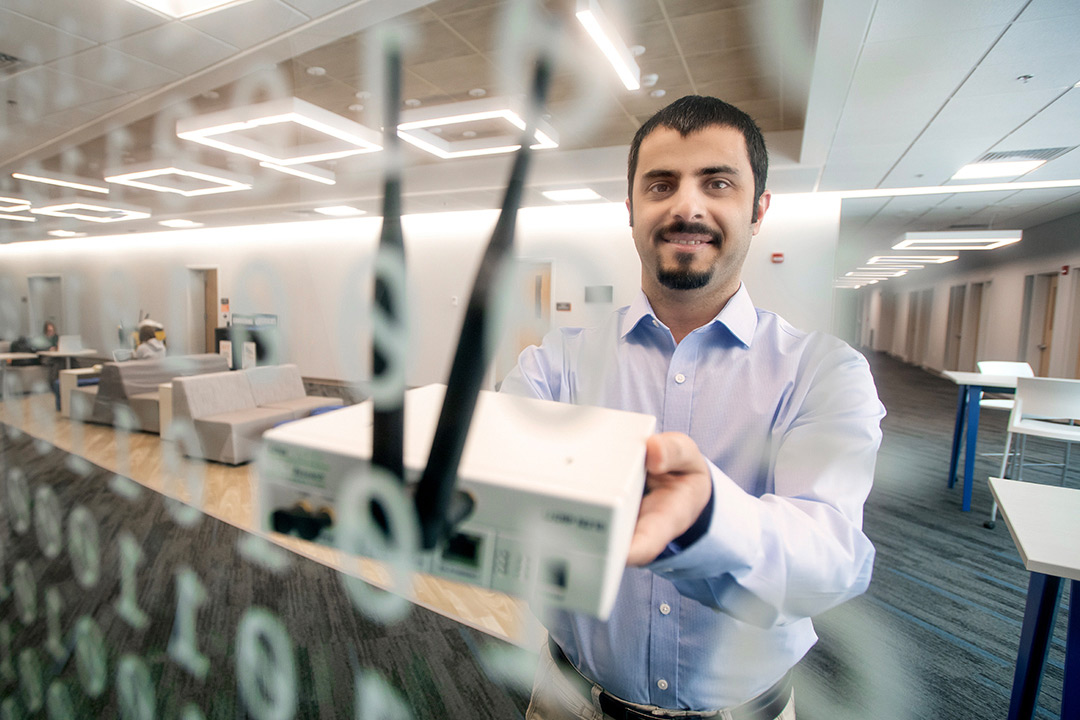Hanif Rahbari earns NSF CAREER Award to enhance connected vehicle security
Professor aims to make connected vehicles more reliable and secure against quantum attacks
Carlos Ortiz
Hanif Rahbari recently received a NSF CAREER Award to study connected vehicle security and protect against quantum attacks.
Driver assistance and autonomous driving systems have the potential to save tens of thousands of lives every year. However, the advanced wireless systems for connected vehicles that will make these technologies possible are vulnerable to cyberattacks.
Hanif Rahbari, an assistant professor of computing security at Rochester Institute of Technology, recently received a prestigious National Science Foundation Faculty Early Career Development (CAREER) award and $600,000 grant to enhance the security of connected vehicle technology. His five-year project is titled “Toward Reliable and Quantum-resistant Connected Vehicle Security.”
Through his work, Rahbari is developing and validating new protocols to secure the growing connected vehicle ecosystems already in use today. The techniques he creates will also protect wireless communications among vehicles from quantum-related attacks in the future.
“If we are going to rely on this technology to help human drivers, it needs to be secure and reliable today and 20 years in the future when there are old cars and new attacks,” said Rahbari. “Otherwise, it could make things worse on the road.”
Advanced driver-assistance systems and future automated driving systems will use vehicle-to-vehicle communications to exchange safety data, essentially allowing cars to rapidly and frequently talk with each other. Unfortunately, attacks can target the integrity and availability of these critical messages and cause driving errors. Today’s safety protocols work to thwart these attacks to some extent, but an imminent threat is coming in the form of quantum computing.
“Quantum computing will substantially increase the speed of solving problems but will also advance attacks against the security mechanisms that rely on the difficulty of some of those problems,” Rahbari said. “This could be a real threat by 2035.”
Rahbari is developing a practical roadmap with interim security protocols for a transition plan throughout the next two decades and at least two generations of cellular technologies (5G and 6G). His work will include novel security protocols and evaluation tools enabled by backwards-compatible communication techniques to prevent and mitigate quantum-related attacks. The refined and refocused cellular vehicle-to-everything communication technology will be prepared for a future where connected cars manufactured before the quantum computing era can still defend against upcoming quantum attacks—including those that intend to forge safety messages.
Post-quantum cryptography researchers are working with the National Institute of Standards and Technology to design cryptographic systems that can withstand the assault of future quantum computers. However, current wireless communication technology for connected vehicles is not capable enough to adopt the post-quantum algorithms being developed today.
Rahbari hopes to balance the constraints of hardware and communication protocols with the evolution of post-quantum algorithms by optimizing and developing new communication techniques using machine learning.
To develop and test all of this work, Rahbari is bringing together interdisciplinary expertise from RIT’s ESL Global Cybersecurity Institute, School of Interactive Games and Media, and students from RIT’s electrical and computer engineering Ph.D. and computing and information technologies Ph.D. programs.
As an integral part of the project, the team will develop a digital twin of a vehicle-to-vehicle (V2V) communication system on actual roadways infused with software-defined radio for over-the-air transmissions that can be used to realistically evaluate techniques and protocols on a large scale. The digital twin will also be used to develop novel games to gamify the connected vehicle security training and education.
“This digital twin will allow RIT and other institutions to evaluate the technology inside, both safely and inexpensively—instead of first running costly experiments on the urban road,” said Rahbari.
Diverse communities, including RIT students who are deaf and hard-of-hearing, will play a key role in development of these inclusive connected vehicle technologies. Rahbari also plans to collaborate with automobile companies and standardization bodies.
“After a few years investigating this problem from multiple angles, I could figure out how to solve it—it just needed effort,” said Rahbari. “I realized that I had a chance to do something that makes the future safer and I decided to build my career around this. I’m excited for the challenge.”
The prestigious CAREER Award program recognizes and supports junior faculty who exemplify the role of teacher-scholars through integrated research and educational activities. RIT has more than a dozen NSF CAREER award winners working at the university.













